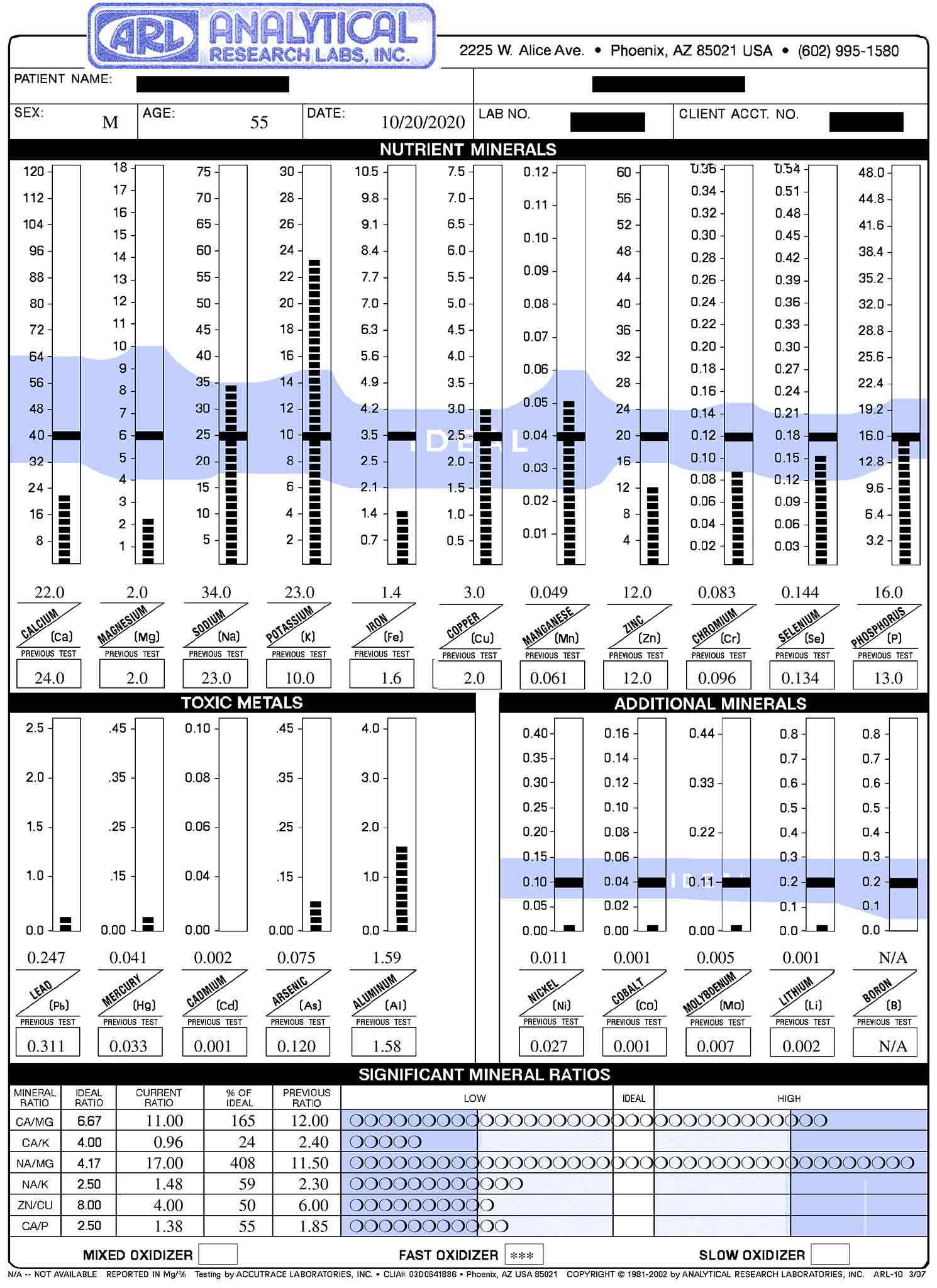

Figure 1. Hair Mineral Balancing Chart
Minerals provide the basic structure for the human body through bones and teeth, they maintain bodily functions through neurological, muscular and acid-base balance, while also regulating cellular metabolism through hormones and enzymes1. Hair Tissue Mineral Analysis, is a non-invasive biopsy that measures the element content of a hair tissue sample from the scalp (nape of the neck) or arm pit if bald. The Analytical Research Laboratory uses a Perkin Elmer Elan 9000 ICP Mass Spectrometer to assess mineral levels in your hair sample in parts per million or parts per billion to provide a report (Figure 1) profiling the major and trace minerals including some toxic minerals.
 Dr. Paul Eck (1925-1996) was a passionate mineral researcher who devoted his life to health and healing. He discovered that every single mineral in the body has an effect on every other mineral in the body thus requiring balancing not supplementation for optimal health. So if just one mineral is imbalanced in the body, this affects all minerals by starting a chain reaction of mineral imbalances. For example, he suggested thousands of people take iron tablets because they are tired. Unfortunately, he discovered that if iron is not taken in the right ratio with other minerals, it could make you more tired. This is because everybody’s mineral chart (Figure 1) is different and the amount of iron, and other minerals, which you need for more energy may be completely different for each person. Hence, mineral balancing aims to replenish at least twenty-one minerals. Re-mineralising the body is not the same as the supplementation of minerals. Re-mineralisation seeks to provide the correct balance of minerals using key macro-mineral ratios, while improving digestion, so minerals can be absorbed and utilised to help the body conserve its own minerals. Dr. L. Wilson studied with Dr. Eck for 14 years (1982-1996) and continues his work adding several modalities for example, near infrared saunas and coffee enemas to complement hair mineral balancing.
Dr. Paul Eck (1925-1996) was a passionate mineral researcher who devoted his life to health and healing. He discovered that every single mineral in the body has an effect on every other mineral in the body thus requiring balancing not supplementation for optimal health. So if just one mineral is imbalanced in the body, this affects all minerals by starting a chain reaction of mineral imbalances. For example, he suggested thousands of people take iron tablets because they are tired. Unfortunately, he discovered that if iron is not taken in the right ratio with other minerals, it could make you more tired. This is because everybody’s mineral chart (Figure 1) is different and the amount of iron, and other minerals, which you need for more energy may be completely different for each person. Hence, mineral balancing aims to replenish at least twenty-one minerals. Re-mineralising the body is not the same as the supplementation of minerals. Re-mineralisation seeks to provide the correct balance of minerals using key macro-mineral ratios, while improving digestion, so minerals can be absorbed and utilised to help the body conserve its own minerals. Dr. L. Wilson studied with Dr. Eck for 14 years (1982-1996) and continues his work adding several modalities for example, near infrared saunas and coffee enemas to complement hair mineral balancing.
Diet is an essential underlying component of hair mineral balancing and a personalised diet plan is provided where 70% is from cooked vegetables, where meat is included (except pork). De-emphasised are fruits and some grains owing to their hybridisation and processing with a consequential affect on health. Fruits and vegetables have seen average mineral losses between 1940-1991 in the UK of 49% of Sodium,16% of Potassium, 24% of Magnesium, 46% of Calcium, 27% of Iron and 76% of Copper2. There was a 9% increase in phosphorus owing to the chemical fertilisers used. Ideally eating organic food is preferable because of their increased mineral content over commercial foods3,4.
The individually recommended minerals along with a personalised diet are the basses of the programme, which can require some commitment to eliminate eating junk and processed foods. If you would like to tackle your health issues or improve your health, correcting mineral imbalances is a foundational approach. This approach aims to build vitality and as a consequence health issues are potentially resolved.
Please contact Dr. Graham Fletcher for further information by submitting the below form. Note, that clients can live anywhere in the world because we can work via telephone, Skype and email.